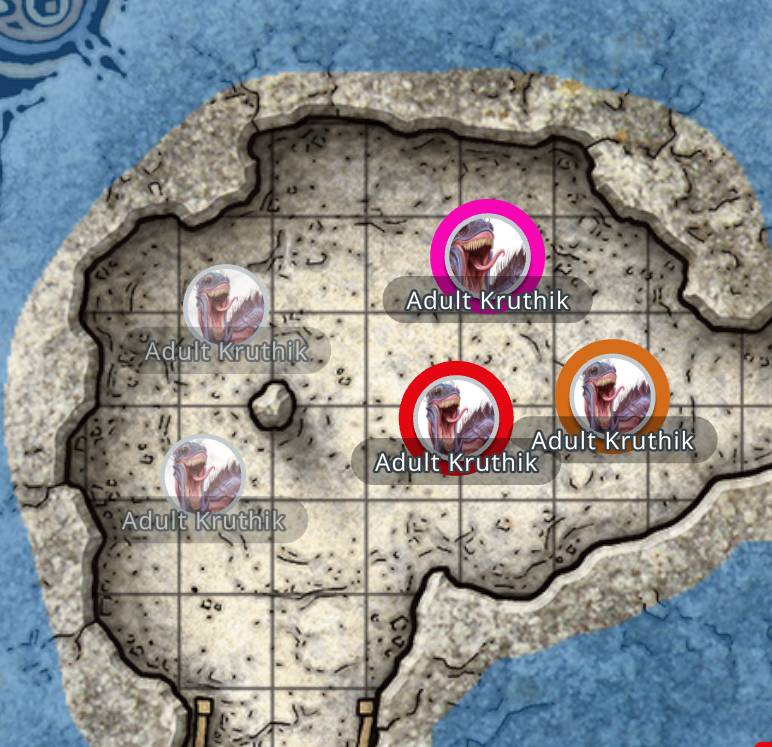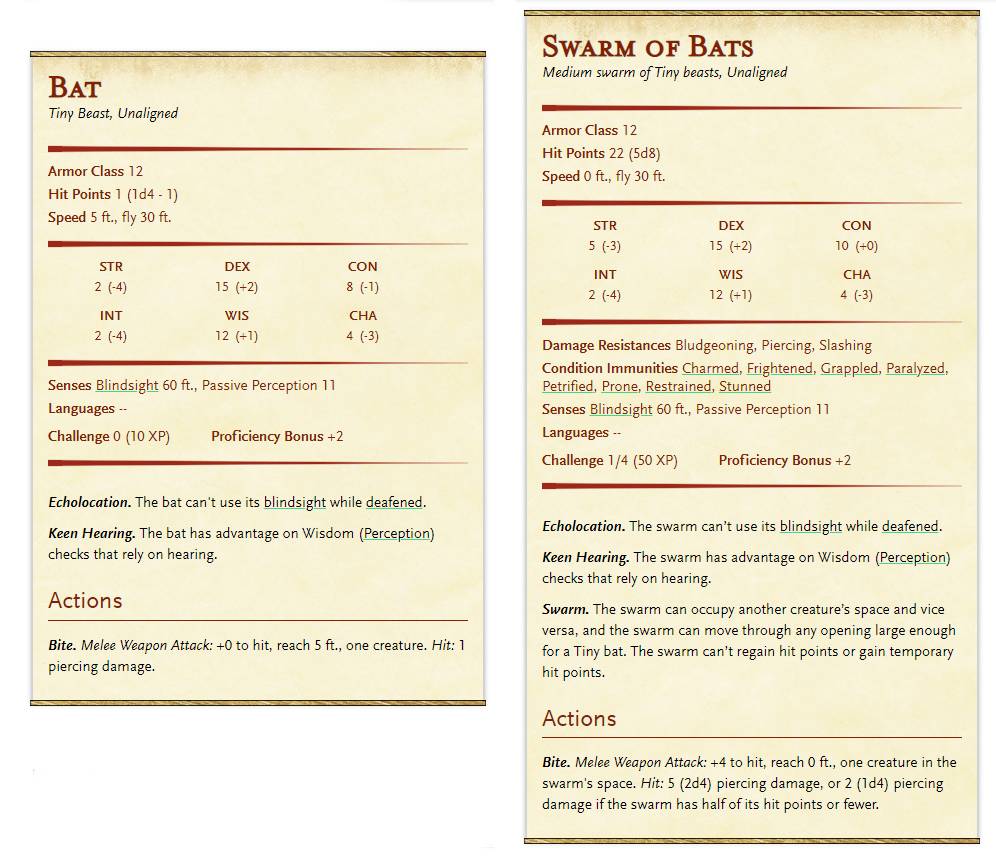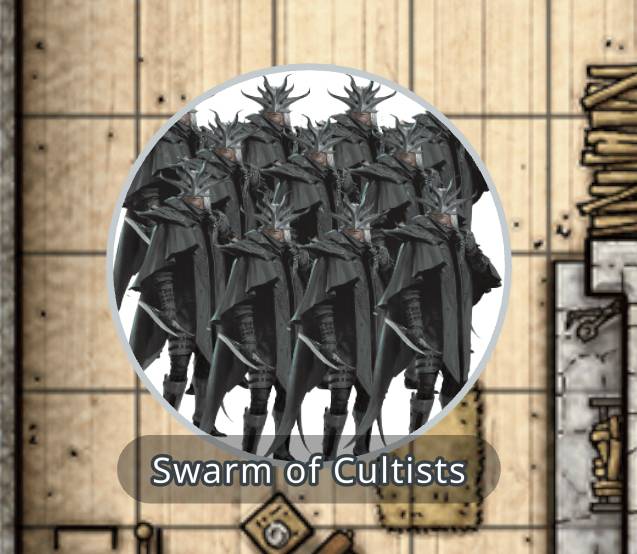The protagonists stand on a bluff, overlooking countless enemies clashing their swords below in a display of power through incalculable numbers. They look to each other, nod, and dive into the fray, plunging head-first into a sea of death and destruction.
There is nothing more cinematic than the heroes facing down an enemy that vastly outnumbers them. But how do you bring this drama and action to D&D without falling to the sheer weight of numbers yourself?
In this article, I’ll cover three different approaches to horde combat so you can use overwhelming forces without being overwhelmed!
A Handful of Hints for Handling Hordes
- It’s easier to use a small selection of moderately complex stat blocks than a lot of different simple ones.
- Use average hit points and average damage.
- The Mob Attacks table from chapter 8 of the Dungeon Master’s Guide can speed up combat.
- Recycle tokens by hiding them or moving them off the map when they’re killed rather than deleting them.
- Use waves of enemies to give your players a breather and avoid combat becoming monotonous.
Reuse, Repair, Recycle
When running an encounter with lots of enemies, it’s very easy to get bogged down with all the tokens or minis you might be using, especially when it comes to tracking which lich is which.
In order to mitigate this, I prefer to use a smaller number of tokens and cycle them in and out, reusing them throughout the encounter. I’m going to explain this using Maps, which is an official VTT, but the principle applies much the same way when using physical tokens or minis.
When you place a token on the map, it’s visible to the players as long as three things are true:
- The session is active
- The token is set to visible
- The token isn’t in a fog of war area
When initially placing tokens for an encounter, you can use the visibility option to hide them from your players until you’re ready to start the encounter.
While hidden this way, you can still interact with them, allowing you to also set the border color option, which is the next key step in tracking lots of monsters. By giving each monster a unique border color, you can more easily track which ones have taken damage.

When a monster is killed, you have two options: Set its visibility to hidden or move it into an area concealed by the fog of war. I like to do the latter because it’s quick and serves as a reminder that it’s a monster token waiting to be reused on the next wave.
Once I move a token into a concealed area, I’ll also remove the border color, so I know it’s ready to be re-used.

You can even use the Draw feature to create pens where you corral your tokens ready to be reused.
Everything is a Swarm
If you want to cut down your tokens without cutting down your monsters (you can leave that to your players), swarms can be the way to go. A swarm represents a cluster of the same type of monster acting as a single horde and are very flexible. You can have anything be a swarm, from bats to rats to skeletons to animated books. But how do you go about converting a monster of choice into a swarm? Let’s look at the difference between a monster and its swarm version to see what changes we need to make.
We’ll use the bat and swarm of bats stat blocks and compare their main differences:

If we compare the stat blocks, we can see the following differences:
- The size category increases by two—from Tiny to Medium
- The hit die goes from a d4 to a d8. This is because hit dice for monsters are tied to size category: d4 for Tiny and d8 for Medium.
- The swarm gains resistance to Bludgeoning, Piercing, and Slashing damage and also gains immunity to a number of conditions that would make sense to affect a single monster but not multiple.
- It gains the Swarm trait, which allows it to occupy the same space as another creature, move through any space big enough for a singular bat, and also cannot regain Hit Points.
- Its attack can only target creatures occupying the same space as it and does more damage. However, the damage is halved if the swarm is below half its starting Hit Points.
With that in mind, if you want to convert an existing monster into a swarm, here is what I would recommend. Note that simpler monsters, without special traits or too many attacks, generally work better as swarms:
- Increase the monster’s size category by one or two sizes.
- Increase its Hit Dice to match its new size category. Hit Dice scale as follows:
- Tiny - d4
- Small - d6
- Medium - d8
- Large - d10
- Huge - d12
- Gargantuan - d20
- Give it resistance to Bludgeoning, Piercing, and Slashing damage and immunity to the following conditions: Charmed, Frightened, Grappled, Paralyzed, Petrified, Prone, Restrained, and Stunned.
- Give it the Swarm trait: Swarm. The swarm can occupy another creature’s space and vice versa, and the swarm can move through any opening large enough for a [original monster]. The swarm can’t regain Hit points or gain Temporary Hit Points.
- Increase the damage of its attacks by up to 50%, but reduce the reach to 0 feet, seeing as the swarm can only target creatures it’s sharing a space with. The swarm also does half damage if it has fewer than half of its starting Hit Points
- Increase its CR by 2 due to having increased Hit Points and damage output.
- Finally, and optionally, make some sweet custom art using your image editor of choice.

Bring Me My Minions
My third piece of advice for using large numbers of monsters effectively and with as little hassle as possible is a callback to the fourth edition of D&D: minions.
Minions were a special class of monsters that hit a little harder, had stronger defenses, and didn’t take damage from missed attacks or successful saves, but only had a single Hit Point. This meant you could throw dozens of them at your players, and they’d simply cut through them like a flame tongue sword through butter.
Minions don’t really exist in D&D fifth edition, but it’s not too hard to concoct a template to turn a monster into a minion. Much like swarms, this generally works better for simpler monsters without complicated features or lots of attacks.
- The monster gets a +2 to AC, attack rolls, damage rolls, and saving throws.
- The monster has a version of the Evasion trait: Evasion. If the [monster name] is subjected to an effect that allows it to make a saving throw to take only half damage, the [monster] instead takes no damage if it succeeds on the saving throw.
- Most importantly, the monster has 1 Hit Point. It also loses any damage resistances or immunities.
With this, you should have a monster that you can use in massive waves that won’t bog you down with tracking Hit Points. Minions don’t even have to hit with their attacks or even make an attack; their sheer numbers can be a challenge in its own right.
Use Optional Rules for Cleaving
Minions work exceptionally well with one of my favorite optional rules from the Dungeon Master’s Guide: Cleave through Creatures.
This rule found in chapter 9 allows a creature to carry excess damage from a melee attack that kills a creature over to another creature. When you have minions, this can mean the players are racking up a serious number of downed enemies on their turn and allows each minion to function almost like a single Hit Point on a bigger monster.
This rule is also great for giving martial characters that extra something special if you feel they need it.
Mass Monster Round-Up
So there you have it, my three tricks to running a veritable creature cornucopia using various tools such as Maps, homebrew, and optional rules in the Dungeon Master’s Guide. With these tricks you can up the scale of your combat encounters. However, as tempting as it can be to run an army of monsters, there are some important things to remember:
- Having lots of creatures can slow down initiative, so in addition to using the mob rules, don’t forget to use the initiative rule, where you make a single initiative roll for identical creatures, and they act at the same time.
- The more creatures you have attacking the players, the more likely things like Critical Hits and conditions become. As such, use creatures that are weaker than you’d normally pick. You can always add more waves later in the combat.
- When it comes to balancing encounters, especially when using lots of monsters, it’s generally better to aim low in terms of difficulty and increase it on the fly than the other way around. It’s easier to come back from a too-easy encounter than a too-hard one.

Davyd is a moderator for D&D Beyond. A Dungeon Master of over fifteen years, he enjoys Marvel movies, writing, and of course running D&D for his friends and family, including his wife Steph and his daughter Willow (well, one day). They live with their two cats Khatleesi and Mollie in the south of England.








-
View User Profile
-
Send Message
Posted May 30, 2024Well written article, I was wondering about how to do this for a long time.
It is a little sad though to see the article go "this doesn't exist in 5e but here's how to do it" not because the solutions weren't good (they were good) but because those things don't exist in 5e, 10 years in. I guess this old quote fits well: Many such cases
-
View User Profile
-
Send Message
Posted May 30, 2024Great stuff! Easy to read and understand. Specially for newer DM's.
-
View User Profile
-
Send Message
Posted May 30, 2024I saw elsewhere thar you havent yet read flee mortals. If you like minion rules and Monster Roles, you're gonna love it!
I actually did just run a battle (right before this article came out! The timing!) with: 65 cultists, 7 cult “lieutenants”, 1 zombie divine champion turned evil, and 1 supercharged Minotaur skeleton, as a mount for the champion.
I ran the 65 cultists using the minion rules from Flee Mortals, and it worked great! Highly recommend.
That said, I’d suggest an addition to the article: rule 0, talk to your players! Tell them “hey guys, I’m not gonna be able to run 65 cultists in a single battle, so I’d like to use “minion rules”. Before the session we’ll go over how they work, so no one is surprised.”
The great thing that happened was that my players helped me remember the rules that were new to me, and they really bought in not just to the story that was being told, but also the tools we were using to tell it. It was one of my favorite sessions in a long time!!
-
View User Profile
-
Send Message
Posted May 31, 2024There are always so many optional rules I think many people miss (including myself!) and these serve as a great reminder of those. I cant say I ever have played in a campaign that used the Cleave through Creatures rule. But dang, that would be great for some martial fighters to utilize.
-
View User Profile
-
Send Message
Posted May 31, 2024Big swing and a miss to not even mention MCDM's minions in Flee, Mortals! James Introcaso deserves an award for his minions design in that book. Even more shocking it wasn't mentioned in this D&D Beyond article since it was JUST released on D&D Beyond.
D&D Beyond leadership may want to consider a rewrite of this article...
-
View User Profile
-
Send Message
Posted May 31, 2024It was only recently made available on your website, but it has been available for purchase for almost a year.
-
View User Profile
-
Send Message
Posted Jun 1, 2024In the Everything is a Swarm section, you talked about adjusting the Hit Die type (d4 to d8) in #2, but never mentioned increasing the number of dice. The bat has 1d4 and the swarm of bats has 5d8 hit dice. Does that mean that all swarms have 5 times the number of dice for hit die or is that figured out a different way?
-
View User Profile
-
Send Message
Posted Jun 1, 2024I'm aware, I was responding to the fact they mentioned the book becoming available on D&D Beyond and that I didn't mention that detail.
-
View User Profile
-
Send Message
Posted Jun 1, 2024Ah, the difference in number of hit dice between the bat and swarm of bats stat blocks is because the designers wanted the latter to have more hit points to satisfier a higher CR, not because of any conversion process between singular and swarm monsters. The process I described is a very simple set of steps I reverse engineered by comparing various swarm stat blocks and applying the rules in the Dungeon Master's Guide, specifically the one that says hit dice size is based on size category. Because you increase the size category of the swarm, you increase the size of the hit dice accordingly.
-
View User Profile
-
Send Message
Posted Jun 1, 2024I didn't actually take my inspiration for minions from Flee, Mortals!, a book I didn't have a chance to read until after I wrote this article. I took inspiration from the same place the designers of Flee, Mortals! did; D&D 4th edition. I call out my inspiration in this article, as an avid enjoyer of the design of D&D 4th edition, and it would be dishonest to credit that to another source just to drive attention to a book newly available on the site. There's not going to be a re-write because it wouldn't reflect the truth behind my work.
-
View User Profile
-
Send Message
Posted Jun 1, 2024I'm a huge fan of optional rules and I can't wait to see what the 2024 Dungeon Master's Guide brings. With any luck, I'll have the opportunity to write about what new tools and ideas are made available come the release of the new core rulebooks
-
View User Profile
-
Send Message
Posted Jun 3, 2024is there a way to save this for later (other than copying the link)?
-
View User Profile
-
Send Message
Posted Jun 7, 2024Thanks for the article! Definitely saving this to use later!
-
View User Profile
-
Send Message
Posted Jun 8, 2024need more dm articles like this. great article
-
View User Profile
-
Send Message
Posted Jun 10, 2024Just FYI on Minions... if you have access to the MCDM "Flee, Mortals" sourcebook on the the D&D Beyond site here, it has Matt Colville's latest Minion rules in there. Extremely well thought out, and in my opinion, a big improvement on 4e's rules!
-
View User Profile
-
Send Message
Posted Jun 11, 2024i am about to unleash a horde of parasite demons on my players and the swarm i created just wasnt big enough, this article really helped me.
-
View User Profile
-
Send Message
Posted Nov 19, 2024The optional Cleaving rule says damage only carries over if the target was undamaged. Why have this?
As I see it, it makes attackers change their strategy to attack undamaged creatures, just for the small benefit of speeding up an encounter by wasting fewest damage points.
In the minion scenario above where each creature has only 1 HP, it makes no difference.